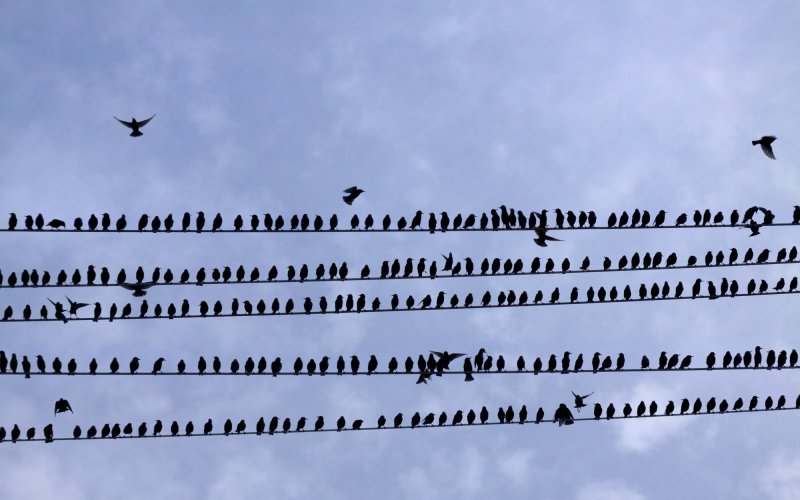There are signs on power poles saying it is dangerous to climb up and touch the wires. In the media I can find frightening stories of people who have climbed up to the wires and been killed or mutilated by electricity. At the same time, I often see birds perched on high voltage wires. How is it that they can touch the wires and it doesn't do anything to them?
Depending on the distribution power lines of the country in which the bird lives, it can choose to sit on lines with a voltage of 100—400 kV, in some parts of the world even up to 800 kV. Electricity with such a high voltage has low transmission losses and is easier to transport over long distances from power plants to cities and factories. Here it is transformed to lower voltages.
To keep the cost of power transmission as economical as possible, uninsulated wires are used. They are protected for free by the air which is a very poor conductor. To prevent the wires from touching the power poles, they are suspended from them by a series of glass or ceramic insulators.
In the event of contact, a strong electric current would flow between the ground and the wire. If a human body stood in the way, the energy would be enough to cause convulsions, breathing stoppage, burns and death. Why doesn’t something like that happen to a cute little bird perched on a wire?
In order for current to flow between two places, there must be some electrical potential between them. The magnitude of this potential describes the voltage. The higher the voltage, the more current will flow if the two places are conductively connected. But the bird’s feet are only on one wire. There is no potential difference, no voltage, and therefore no current flowing between its right and left legs.
Strictly speaking, this is not entirely true. If DC current were flowing through the wire, no electricity would really flow through the bird at all. But there's alternating current flowing through the wire. The voltage in the wire changes periodically, and so does the voltage of the bird touching the wire. At a normal frequency of 50 Hz, we can say that the bird is being charged and discharged 50 times a second. However, the amount of charge that can flow in and out of the bird is very small, and therefore the current through the bird is also small. Maybe it doesn’t feel it at all, maybe it experiences sitting on a wire of very high voltage as a nice foot massage.
However, sitting on the wire is not without risk for the bird. In a conventional three-phase system, the mast carries the wires of all three phases, and the voltage between two phases is significant enough to grill a bird if it were careless enough to connect the two phases conductively with its own body. When we look at the mast, we often see several triplets of wires. One triplet corresponds to one phase. They’re fixed so that they can't come close to each other even in a strong wind, separated by several metres of space. No matter how much it spreads its wings, a small bird the size of a swallow cannot touch both phases at once.
This danger already threatens the big birds. Eagles, herons, storks and other large birds are electrocuted every year. The bird is at risk even when it’s standing on a pole. During take-off, it can connect a grounded pole and one of the phases with its wings.
In fact, it may not even touch the wire directly. The voltage is so great that it ionises the air around the wire and a conductive channel can be formed by approaching within a few centimetres.
It would seem that a secure perch for the bird would be a grounding wire. This connects the tops of power line poles and is not used to transmit electricity. It links the individual poles and serves as a lightning protection. The grounding wire safely conducts such a discharge through the nearest pole to the ground. The grounding wire also often contains a fibre optic, which sends information important to the distribution system. Although no current passes through the grounding wire, because it is connected to ground through the poles, there is a dangerously high voltage between it and any phase.
Compared to sitting on a tree, sitting on high-voltage wires is a bit of an adrenaline sport for birds. It’s safe, but not nearly as safe as a good old-fashioned branch.
Want to ask something?
Send us an e-mail with the subject “Physics mysteries” to the address:
We can't wait to tackle your interesting questions!





